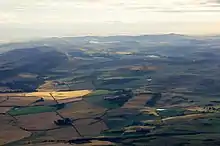Sidlaws
The Sidlaws (Scottish Gaelic: Na Sidhbheanntan ), also called the Sidlaw Hills and Sidlaw Range, are a range of hills partly of volcanic origin in the counties of Perthshire and Angus in Scotland that extend for 30 miles (45 km) from Kinnoull Hill, near Perth, northeast to Forfar.[1] Principal peaks within the Sidlaws include Craigowl Hill, Ark Hill and King's Seat.

Points of interest include Dunsinane Hill, mentioned in Shakespeare's play Macbeth, and Auchterhouse Hill, which was the site of an ancient hill fort. The ruined observatory on Kinpurnie Hill was built by James Stuart-Mackenzie who owned the Kinpurnie estate and can be seen for many miles on the Strathmore side of the Sidlaws. There is a local legend that a poacher named Brandon Henderson lived as a hermit in the tower for seven years in order to win a £100 bet.[2]
The highest of the Sidlaws is Craigowl Hill, to the north of Dundee. Adjacent to Craigowl Hill is Gallow Hill, on the side of which is located the Angus transmitting station, which provides television and radio services to the region.
Nearby historical features to the north include Glamis Castle and the Eassie Stone, a carved Pictish cross slab-stone (now situated in a ruined church in the village of Eassie).[3]
Sidlaw Hills is also the name of a Schottische marching tune composed for the fiddle by Jim Watson[4] of Blairgowrie (1868 - 1931)
Geology
The Sidlaws are formed from a mix of igneous and sedimentary rocks originating during the early part of the Devonian period.
The Dundee Flagstones are a mix of slabby and cross-bedded sandstones with some siltstones and mudstones which interleave with the rocks of the overlying Ochil Volcanic Formation. They form the bulk of the hills along the southern margin of the range from Scotston Hill and the eastern slopes of Balkello Hill in the west, through Craigowl Hill, much of Gallow Hill, Ironside Hill and Finlarg Hill to Kincaldrum Hill in the east, together with the outlying Fothringham Hill and Carrot Hill ridge. The Dundee Flagstones were intruded by rocks of the 'Midland Valley Siluro-Devonian Mafic Intrusion Suite'; these outcrop on parts of Auchterhouse and Scotston hills, Blacklaw and West Mains hills.
The Ochil Volcanics form the sometimes craggy King's Seat, Gask Hill, Northballo and Southballo hills and the ridge north and west of Long Loch; Lundie Craigs are a significant southeast facing exposure of this formation. They are also found across the larger part of Carlunie Hill and Berry Hillock together with Kinpurney Hill. The overlying Scone Sandstone forms the hill of Castleward and underlies the low ground of Strathmore to the north.
Much of the lower ground around and within the hills is covered by glacial till, a legacy of the last ice age. Glaciofluvial deposits from the late stages of the ice age and post-glacial alluvium are also widespread.[5]
Beautifully coloured agates, which formed over millions of years in cavities (originally gas bubbles) in the volcanic lava which formed the hills, are occasionally to be found weathered out of the rock in the surrounding fields.
See also
References
- United Kingdom Ordnance Survey Map, Landranger (2005)
- Nelson, Douglas. "Kinpurnie Tower (C) Douglas Nelson :: Geograph Britain and Ireland". Retrieved 15 July 2014.
- C.Michael Hogan, Eassie Stone, The Megalithic Portal, ed. Andy Burnham, 7 October 2007
- Tom Hughes and His Border Fiddle Archived 28 February 2007 at the Wayback Machine
- "GeoIndex Onshore". British Geological Survey. Retrieved 17 July 2020.
External links
| Wikimedia Commons has media related to Sidlaw Hills. |